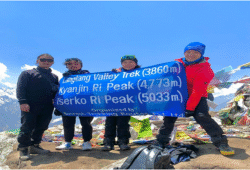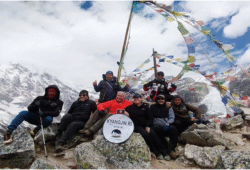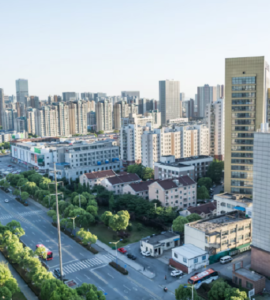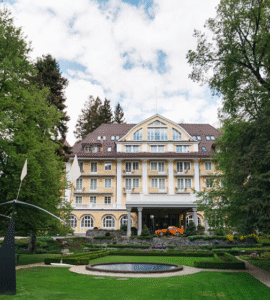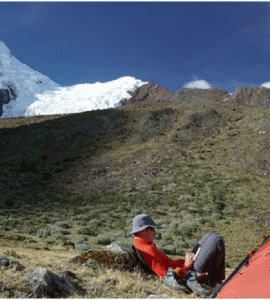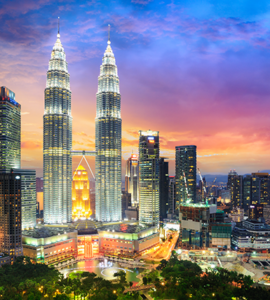 Posted On
Posted On
Manaslu Circuit Trek: An Authentic Himalayan Journey With Sherpa Experts
 Posted On
Posted On
The Manaslu Circuit Trek is amongst the purest and most stimulating Himalayan mountain experiences found in Nepal, and when it comes to walking with Sherpa guides, it is not just a trek; it turns into a meaningful journey. This trail goes around the imposing Mount Manaslu, the 8th highest peak on Earth, through isolated valleys, traditional villages, and dramatic high-altitude terrain. Step by step, the trail uncovers the pristine core of the Himalayas, away from the commercial rush of the busier trekking regions of the same mountains. Trekking with highly experienced Sherpa guides provides not only safety, but also a richly informed and respectful encounter with the land and its people and customs.
Short Manaslu Circuit Trek A lifetime of mountain wisdom from our Sherpa guides for your journey. Combine this with their intuitive understanding of weather, terrain, and altitude acclimatisation, together with their natural warmth and cultural insight, and group treks offer something extra you don’t often find in self-guided or solo trips. Their existence also boosts ties with the local communities that line up the path — in villages like Sama Gaun and Lho, you are invited into simple teahouses, in Tibet-flavored hamlets whose stores range from a glass-fronted Apple-supply boutique to a shop filled with dried yak tongues, to the hard scrabble of actual subsistence living.
With lowland passes through subtropical forests and snowy ascents of the Haute Route pass at 5,160 meters, the route offers a diverse palette of landscapes and perspectives. On the way, glacial rivers, sacred monasteries, and mountain wildlife lend color to the trip. The experience of a Sherpa guide ensures that all challenges, from steep climbs to cold nights, are navigated with confidence, care, and camaraderie. The Manaslu Circuit trek organised by Sherpa experts is not only a trek but an adventure that glorifies nature, culture, and the essence of the Himalayas.
The Manaslu Circuit Trek, being one of the less frequented trails into the Himalayas, offers a perfect amalgamation of pristine nature, rich culture, and adventure. Looping around Mount Manaslu (8,163 meters), the eighth-highest mountain in the world, this trek is increasingly popular for those interested in seeing more of the relatively unvisited region that sits far from the commercial trekking routes of Everest and Annapurna.
The journey traverses deep river valleys, isolated mountain villages, and untouched high-alpine country before gradually heading up to the dramatic crossing of Larke Pass (5,106m). What makes the Manaslu Circuit unique is not mere jaw-dropping views but also its deep-seated Tibetan culture, heartfelt teahouse hospitality, and all-pervading sense of spirit that few treks can provide.
Whether you’re an accomplished high-altitude trekker or a weekend warrior who never misses the opportunity to challenge yourself with something new, the Manaslu Circuit offers the perfect mix of challenge and beauty. It’s a journey that’s as much about the soul as it is the body: quiet trails, powerful cultural exchanges, and opportunities to feel the awe that comes from nature.
In this guide, we’ll look at what makes the Manaslu Circuit a standout trek, the importance of hiring knowledgeable Sherpas, the cultural opportunities you get along the way, and some of the scenic highlights that make this trek unforgettable.
Why the Manaslu Circuit trek?
Opting for the Manaslu Circuit Trek is entering into a world of pristine, picturesque, rich culture, and real adventure. Popular treks such as the Everest Base Camp and the Annapurna Circuit lure thousands of trekkers every year, but on Manaslu, it all feels a bit quieter — a bit more personal. This is a great circuit for getting far off the beaten track in Nepal’s remote mountain areas.
One of the top reasons for choosing Manaslu is its remoteness. As a restricted region, it calls for a special permit and a registered guide, naturally limiting the number of trekkers and protecting the authenticity of the region. The byproducts are quieter trails, less crowded teahouses, and a more meaningful experience with the natural beauty and the local people.
The scenery along the route is a mysterious mishmash of nature, as you pass from subtropical forests and rushing rivers to high alpine passes and glacier-covered peaks. The scenery changes daily, if not hourly, so this is a walk to enlighten.
The cultural experience is also unparalleled compared with many of the more commercial treks. Each of the villages you visit on these hikes — like Lho, Samagaon, and Samdo — is steeped in the traditions of Tibetan Buddhism, and the people you meet give you a sense of a way of life that hasn’t changed in centuries.
For travellers in search of a more genuine Himalayan experience, and one that is off the beaten track, we would highly recommend the Manaslu Circuit. It will be equally adventurous, peaceful, and connecting — a trek you will treasure for life.
The Role of Sherpa Experts on the Trek
On a journey such as the Manaslu Circuit, one of the most remote and challenging treks in Nepal, expert Sherpa support can be the difference between making it or not. Sherpas are not only famous for their strength and acclimatisation at high altitudes, but also for their intimate knowledge of the Himalayas, the land, and what trekkers require in these harsh conditions.
One of the reasons a licensed Sherpa guide is so necessary on the Manaslu Circuit isn’t just that it’s a restricted area and you’re legally required to have one, it is also because their experience will help make sure that you are safe, comfortable, and happy all along the way. Sherpas help with route finding, setting the pace, and managing altitude, ensuring that you acclimate appropriately and don’t run into common problems like altitude sickness or fatigue.
Sherpas are more than just physical guides; they act as cultural ambassadors. They put the monasteries, prayer flags, and local customs you experience along the way into context. They open doors with local villagers, translating conversations and sharing details of everyday life in the isolated highlands. Their tales and good spirits give warmth and human connection to the journey.
Porters — frequently members of the Sherpa ethnic group or the villagers who live in the valleys on the way to base camp — are important as well, carrying your stuff and lightening your load and allowing you to enjoy the trek more fully. Their courage is both humbling and empowering.
Manaslu Circuit Trek Nepal Cooperation with the Sherpa-owned companies, such as Sherpa Expedition & Trekking, provides an experience with professionalism and local knowledge and enhances the local economy. The Manaslu Circuit isn’t merely a trek—it’s a journey, navigated with Himalayan wisdom by your Sherpa at your side.
Cultural experiences and Insider accessNavigatorMove
A highlight of the Manaslu Circuit Trek is the incredible cultural experience that is made possible. In contrast to the more established treks, the villages along this route are and have been largely free of modernization, permitting us the opportunity to enjoy an authentic experience of historical Himalayan culture and its lifestyle practices.
As you pass through the trail, from lower-lying villages like Philim up to the higher-altitude settlements of Lho, Samagaon, and Samdo, you’ll notice a gradual culture change. Hindu traditions and culture the lower zones, and the Muslim ethnic people live in the southern part of the villages, whereas the Upper Manaslu region is influenced by Tibetan Buddhism. Monasteries, mani walls, prayer wheels, and Chortens (Stupas) can be seen in abundance, all with symbolic and spiritual meaning.
Sleeping in locally run teahouses only adds to the immersion. These small lodges are more than food and shelter — they show a glimpse of everyday computer life. You’ll eat classic fare like dal bhat, yak chees, and Tibetan bread, and may even participate in local festivities or hear folk tales as told by your hosts.
Your guide or Sherpa is frequently a cultural intermediary, explaining everything from rituals to language to local customs. By taking care to learn local customs and properly engage with the villagers you journey with, people can be added to such a trek in a way that makes it into a truly significant encounter rather than just another trek.
When you’re trekking the Manaslu Circuit, you’re not simply moving through a landscape—you’re interacting with a living culture and learning things that will stick with you far beyond the reach of the last village on your route.
Summary Highlights of Highlights and Hidden Gems
The Manaslu Circuit Trek is brimming with photographic and visual delights–scenic treasures and secret gems, which leave even the most experienced hikers spellbound. From towering snow-capped peaks to tranquil alpine lakes and far-flung cultural sites, each step reveals a different patch of arty wonder.
One of the featured scenic attractions is Mount Manaslu itself. Its big wall looms large and is a constant companion as you get closer to Lho and Samagaon, where the mountain’s view is dominating, yet also humbling. The sunrises and sunsets here draw unforgettable hues across the heavens, washing over the glaciers and snowfields in breathtaking displays of magic.
A quick detour to Birendra Lake, a turquoise glacier lake near Samagaon, makes for a serene little oasis and great snaps. Another is the Pungyen Gompa, a centuries-old monastery nestled below towering peaks that’s a spiritual refuge few of the trekkers experience.
Manaslu Circuit Trek Cost And Itinerary The passage through Larke Pass is the trek’s pièce de résistance. More than 5,100 meters above sea level, this high-altitude pass has a sweeping view of the mountains, including Himlung Himal, Cheo Himal, as well as the Annapurna range in the far horizon. It is a tough, albeit stunning climb, which speaks for itself.
Off the beaten path gems include a few small, quaint villages where life still follows the traditional Himalayan pace. These quieter stops have intimate encounters, breathtaking sights, and moments of silence that can end up being the most memorable of the trek.
The Manaslu Circuit is not only about the grandeur—you’ll find beauty in the details, from isolated valleys to flag-bedecked ridgelines, every step of the way.
Hiking — With Safety and a Guide
Experienced Sherpa guides on the Manaslu Circuit trek. Disadvantages One of the major benefits of hiking the Manaslu Circuit is that you’re far off in the Himalayas, and you’re likely to encounter fewer people than you would hiking the Annapurna Circuit. The wilderness and unpredictable weather of the area require preparedness and the leadership of experienced guides who know the mountain well. The Sherpa guides are not only expert navigators and altitude managers but are also trained in first aid and rescue, offering a priceless safety network on the entire journey. Their experience on the trail means they can spot early symptoms of altitude sickness and adjust the pace or schedule to ensure everyone stays healthy and acclimatised.
While obvious from a safety perspective, Sherpa support also adds a personal, cultural depth to the experience. Porters take fluff off the hard-core load, so trekkers might concentrate on the route, not the kilos on their backs. Guides are cultural conduits, explaining local customs, Buddhist sites, and even the spiritual import of numerous sites en route. They are there to support their mental and emotional toughness, to cheer them on through the tough areas, and rejoice in every milestone they reach alongside their friend.
Filled with reverence for the land and its people, Sherpa crews make sure each step is tenderly made. Whether scrabbling on a mud slope on the way down from Larke Pass or crossing a wooden bridge suspended over a white glacial river, it is their steady hand that is a source of comfort. Trekking the Manaslu Circuit is no longer purely an odyssey of self-sufficiency, but rather an adventure with high stakes yet more to gain in terms of knowledge, protection, and reward through the presence of a professional Sherpa guide.
Day-by-Day Itinerary Overview
The Manaslu Circuit trek is 14-18 days (depending on need for acclimatization and side trips) of incomparable trekking, each with its natural and cultural wonders. The trip often starts with a scenic drive from Kathmandu to Machha Khola, before walking the Budhi Gandaki River through dense forests and terraced fields. The first few days climb through Gurung villages, suspension bridges, and rushing waterfalls, as you acclimate to the rhythm of mountain life in the remote wilderness.
Higher still, trekkers ascend beyond the subtropical forests to alpine meadows and rocky trails. Villages such as Namrung, Lho, and Sama Gaun are cultural features with traditional Tibetan architecture, prayer wheels, and historic monasteries. A rest day in Sama Gaun is for acclimatization, but you can take a side trip to Pungyen Gompa and Manaslu Base Camp for stunning views of the mountains and appreciate the spiritual aspirations of the region.
Manaslu Circuit Trek Map The toughest but most rewarding day is crossing Larke Pass at 5,160 meters, a high-altitude expedition that requires an early start, a precise pace up icy terrain. From the summit, the panoramic views of Himlung, Cheo Himal, and Annapurna II are rewarding with every step. The climb down to Bimthang exposes trekkers to new alpine valleys and much greener surroundings as the path meanders through rhododendron forests down to Darapani – the starting point.
Every day on the Manaslu Circuit is a new challenge, a better connection to nature, a more inspiring moment, and one of the most immersive trekking experiences in Nepal.
Accommodation and Food Experience
Lodging and food on the Manaslu Circuit provide a special window into traditional Himalayan hospitality and living. The trail is dotted with teahouses — basic, family-owned lodges that offer warm shelter, hearty meals, and a place to socialize. Services at the tea houses are rudimentary but include what you need for a good night’s sleep: clean rooms, warm blankets, and shared dining rooms where trekkers huddle together to eat and warm up, and to swap a few stories.
Every teahouse is a cultural waypoint that provides insight into local life and cuisine. Breakfasts are usually different, freshly cooked,carb-loaded options that are necessary for trekking fuel. Dal bhat (rice, lentil, and vegetable curry) is a staple and is frequently offered with refills. Momos (dumplings), noodles, fried rice, pasta, and pancakes are also some popular foods within the city. Choices on the menu do get thinner on the ground the higher you climb, but the service is warm enough to make up for it. Many teahouses also serve hot drinks — namely tea, coffee, and ginger-lemon-honey concoctions that help soothe wearied bodies at the end of long days on the trail.
The evenings in teahouses are some of the highlight moments of the entire trek. Sitting around a yak-dung stove talking to other trekkers and locals about what flowers you’ll see tomorrow and hearing the night sounds of mountains — it’s a special sort of peace. It is the rustic character, casual comforts, and authentic encounter in these mountain lodges that really does make the lodging and meals a part of the Manaslu experience: one that channels the mountain people’s hardiness, hospitality, and customs.
Responsible and Sustainable Hiking
Eco responsibility of the Manaslu trek: push further, preserving the fragile ecosystem and showing respect to the places of extraordinary beauty which lie intact in the lap of nature and the cultures of people who live here. Because the trail moves through conservation areas and remote villages, every choice—from how to dispose of waste to how to treat residents—matters. Ethical trekking begins with basic habits- carrying reusable water bottles, eschewing plastic wrapping, and using biodegradable toiletries to reduce the impact of your footprint on the country. It also requires not wandering off established trails, to help protect fragile alpine plants and stem erosion.
Local guides and trek companies led by Sherpa guides put all of a donated dollar directly into the local economy. These teams don’t just provide cultural insights and support: They also keep tourism sustainable, and in a way that benefits the people who maintain the trails, run the teahouses, and protect the surrounding natural beauty. Supporting locally owned teahouses and purchasing handmade items or snacks from village shops helps to circulate money directly within communities.
Another maxim of responsible trekking is to observe local customs. This means asking before you take pictures, dressing conservatively, and learning at least a little bit of Nepali or Tibetan to demonstrate respect for the culture. Sacred sites, including monasteries, mani walls, and chortens, should be respected – walk around them in a clockwise direction at all times and approach quietly.
And by walking mindfully and respectfully, travellers can support conserving the unspoilt beauty and integrity of the Manaslu region for generations to come. ‘’Responsible trekking is not only a habit—it is a way of showing respect to the spirit of the Himalayas and the people who inhabit it.”
Conclusion – A Real Himalayan Adventure.
The Manaslu Circuit Treks Nepal is more than a challenge of the rocks, it is a venture into the natural, spiritual, and breathtaking Himalaya. Every part of the long journey, from the shifting terrains to the ancient cultures we pass, adds a thread to a tale that is at once intimate and transcendent. It’s not the easiest journey in Nepal, but it’s among the most satisfying experiences, with the opportunity for solitude, authenticity, and genuine adventure that’s harder and harder to come by in our increasingly crowded world.
With the professional Sherpa expert assisting and guiding you, the hurdles become easier, and every obstacle is conquered is the moment of glory. Whether it’s the adrenaline of summiting Larke Pass, the tranquillity of a village prayer flag flapping in the wind, or the come-down of a hot cup of tea after a hard day’s walk, there are many moments from the trek that you’ll remember long after you’ve left the trail.
What makes the Manaslu Circuit unique is its purity — the place has yet to be jaded by the human throngs or assaulted by mass tourism and remains unsullied in terms of its spirituality. For a true Himalayan adventure that nourishes both body and soul, the Manaslu Circuit has it in abundance. It’s a journey that imparts patience, builds resilience, and provides a connection to the mountains, to local communities, and to oneself. In every aspect, it is the epitome of a Himalayan adventure in the truest sense.
Is the Manaslu Circuit trek worth it?
The Manaslu Circuit Trek is something worth going the extra mile for, if you are looking for an off-the-beaten-path, genuine Himalayan experience. And in contrast to more-trekked paths such as the Everest Base Camp or Annapurna Circuit, Manaslu is a very real, raw wilderness that is essentially remaining unspoiled. The trek circumnavigates the spectacular Mount Manaslu, with panoramas of glistening mountain ranges, fertile valleys, dense pine and rhododendron forests, and ancient Buddhist villages, in true Tibetan form. En route, there, trekkers will trek through remote communities where life has changed little since time immemorial, providing a cultural experience that would be difficult to replicate elsewhere.
Manaslu Circuit Trek Cost The going is tough, but the returns are great. Trekkers witness not only the breathtaking mountain vistas but also have the opportunity to cross the high-altitude Larke Pass at 5,160 meters, a physically and mentally demanding feat. The hike they have determined involves a range of landscapes, from subtropical forest to alpine meadow, and the difference in terrain makes for a visually stunning and diverse adventure.
The remote nature of the trek and the rich cultural history make the trail one of the most rewarding to hike. The presence of a local guide on the trek also provides trekkers with the confidence that safety and respect for the culture are paramount. The Manaslu Circuit Trek is worth it for those who like a rustic and Himalayan experience.
How difficult is the Manaslu Circuit trek?
The Short Manaslu Circuit Trek is moderately challenging, hence recommended for experienced trekkers or that with a good level of fitness. The primary difficulty is the rapid gain of altitude, as the hike sometimes even exceeds passes of more than 5,000 meters, e. g. Larke Pass. At such altitudes, trekkers should be prepared to deal with the physicality of clambering up and down steep climbs, dropping into valleys, and suffering the effects of the thin air. Altitude sickness is a risk, and acclimatization days are essential to allow the body to adjust to the lower oxygen levels.
The trek is not ascent-wise difficult either, but the challenge is to do this trek for 20 days in a row, walking for an average of 6-8 hours per day. Terrain might change, from a rocky and dusty trail to an icy traverse close to the pass that calls for careful foot placement and balance. The weather is spotty, and even in the higher areas, temperatures can be cold, and snow can blow in.
It is highly recommended to trek with a guide to assist with the route, acclimatization, and safety. Proper preparation, including some physical preparation and appropriate equipment, will ensure that the hike is comfortable and enjoyable. The Manaslu Circuit trek is not a trek for beginners, but for those with moderate experience and a desire to get off the beaten path, it’s a tough trek, be oh so rewarding.
Is Manaslu harder than Everest?
Manaslu Circuit Trek Difficulty The Everest Base Camp Trek and the Manaslu Circuit Trek are both classic Himalayan walks, but,, if I allow myself to express a personal opinion, it’s a question of taste and experience. In terms of physical difficulties, the Manaslu Circuit Trek is usually more difficult compared to the Everest Base Camp Trek in terms of duration of trek, altitude, and walking difficulty. The highest elevation of the Manaslu Circuit is at Larke Pass, 5,160m, higher than the Everest Base Camp at about 5,364m. While the Manaslu Circuit is less established and travelled upon than EBC, and features rougher, more remote trails and fewer teahouses and lodges.
Nothing ever comes without struggles; besides the problems with the altitude, a Manaslu Circuit Trek also comprises longer and harder daily distances with steeper and more difficult ascents and descents. And because it’s more remote, fewer trekkers are venturing that way, and the teahouses tend to be more basic, making the trek feel more remote and physically challenging. The Everest Base Camp Trek is a bit easier to get t,o and there’s a greater sense of community, which can make the experience feel a little easier, not to mention having a marked path and ample opportunities to rest.
All in all, if we compare them both in terms of the scenery and a pure Himalayan experience, you won’t go wrong with either, but the Manaslu circuit is generally on the harder side in terms of height, terrain, and remoteness.
How much does the Manaslu Circuit trek cost?
The price for trekking the Manaslu Circuit Trek Best Time will vary greatly due to the duration of the trek and your trekking company, and preference. It usually costs on average $1,500 to $2,500, but may be more or less depending on your needs. A large share of the cost is permit fees, guides and porters’ charges, accommodations, food, and transport.
Needless to say, the appropriate trekking permits for the Manaslu Circuit include the MCAP (Manaslu Conservation Area Permit), the ACAP, and a special RAP from a Restricted Area because of its closeness to the Tibetan frontier. You will only pay $100 to USD 150 for these permits (plus transport to the start of the trek).
If you opt for a guide and a porter, the cost will increase. Guides usually cost 25-40 dollars per day in U.S. dollars, and porters 15-20 dollars per day. Lodging along the trail is pretty cheap, with teahouses that will run you between $5-10 USD for the night in a basic room. Food is usually around $5 to USD 10 a day.
The remote nature of the trek, lack of teahouses, and need for guides and permits (detailed below) make it more expensive than other treks such as the Annapurna Circuit or Everest Base Camp. But the price is worthwhile for many trekkers for the chance to hike in a quieter, more authentic corner of the Himalayas.

